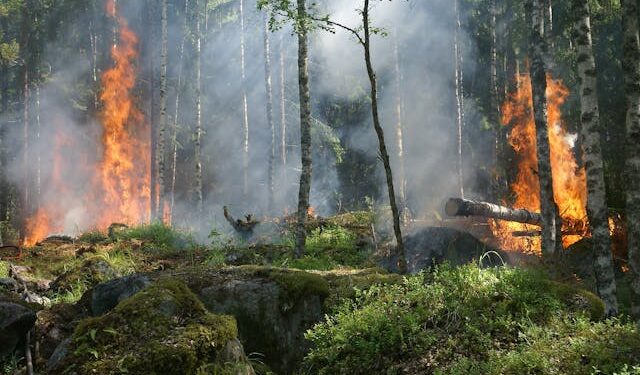Los Angeles, a city known for its sprawling urban landscape and breathtaking natural scenery, has long faced the devastating effects of wildfires. Each year, fires consume thousands of acres, leaving behind a trail of destruction that impacts not only human communities but also the intricate ecosystems and wildlife that call this region home. Yet, amidst the ashes, nature’s resilience shines through. This article explores the impact of wildfires on wildlife and ecosystems in Los Angeles, showcasing the remarkable recovery process and the efforts of conservationists to restore balance.
The Impact of Wildfires on Wildlife and Ecosystems
Wildfires in Los Angeles have profound effects on both wildlife and ecosystems. The immediate aftermath of a wildfire often leaves habitats scorched and barren, displacing countless animals and threatening species that rely on these environments for survival. Iconic species like mountain lions, deer, and bobcats face habitat loss, while smaller animals like birds, reptiles, and insects struggle to find shelter and food.
Beyond the visible destruction, wildfires disrupt the delicate balance of ecosystems. They alter food chains, reduce biodiversity, and lead to soil erosion, making it harder for plants to regrow. However, these challenges are not insurmountable. Wildfires are a natural part of many ecosystems in Southern California, and over time, nature begins to rebuild itself. This highlights the importance of understanding wildfire effects on wildlife and the broader Los Angeles ecosystem resilience.
The Recovery Process: Nature’s Resilience
Despite the devastation, nature has an incredible ability to recover. Shortly after a wildfire, the healing process begins. Fire-adapted plants, such as chaparral shrubs and certain species of pine, are some of the first to return. These plants have evolved to survive fires, with seeds that germinate only after exposure to intense heat. Their regrowth stabilizes the soil, creating a foundation for other vegetation to thrive. This process is a testament to nature recovery in LA.
As vegetation begins to recover, so does wildlife. Birds often return first, feeding on seeds from regenerating plants. Small mammals follow, taking refuge in the emerging greenery. Over time, predators like coyotes and mountain lions make their way back as prey populations stabilize. This gradual rebirth underscores the resilience of Los Angeles’ ecosystem, even in the face of repeated wildfires.
Conservation Efforts and Community Involvement
The recovery of wildlife and ecosystems after wildfires isn’t left entirely to nature. Conservation organizations, scientists, and local communities play a critical role in speeding up the process. Groups like the National Park Service and the California Department of Fish and Wildlife work tirelessly to restore habitats, monitor wildlife populations, and implement fire management strategies.
Reforestation projects are particularly impactful. By planting native trees and vegetation, these initiatives not only accelerate ecological recovery but also reduce the risk of soil erosion and future wildfires. Wildlife rescue efforts also make a significant difference, providing medical care and rehabilitation for injured animals before releasing them back into the wild. These efforts are crucial to wildlife recovery after wildfires.
Community involvement is another crucial component. Volunteer programs often enlist residents to help with habitat restoration, clean-up efforts, and educational campaigns about fire safety. By fostering a sense of collective responsibility, these initiatives ensure a more sustainable approach to wildfire recovery.
Inspiring Stories of Recovery
One inspiring example of nature’s resilience in Los Angeles is the recovery of the Santa Monica Mountains after the Woolsey Fire in 2018. This wildfire burned nearly 100,000 acres, destroying much of the area’s vegetation and displacing wildlife. Yet, within months, green shoots of chaparral began to emerge from the blackened landscape. Animals like mule deer and quail were spotted returning to the area, signaling the slow but steady revival of the ecosystem.
Similarly, the Griffith Park area, which has faced multiple fires over the years, serves as a testament to nature’s ability to bounce back. Native plants like California poppies and lupines now thrive in areas once reduced to ash, providing food and shelter for a variety of wildlife. These stories are powerful examples of nature recovery in LA.
Lessons Learned and Looking Ahead
Wildfires are a reminder of the delicate balance between human activity and nature. They highlight the importance of preserving natural spaces and adopting fire-safe practices to minimize damage. As Los Angeles continues to grapple with wildfires, the stories of recovery serve as a beacon of hope, showcasing the resilience of both nature and the communities dedicated to protecting it.
Call to Action: Support local conservation efforts by donating to organizations working on wildfire recovery, volunteering for habitat restoration projects, or spreading awareness about the importance of sustainable practices. Together, we can help ensure that Los Angeles’ wildlife and ecosystems continue to recover and thrive.
By focusing on the resilience of wildlife and ecosystems after wildfires, this article celebrates the natural and human efforts that drive recovery in Los Angeles. Despite the challenges, the city’s landscapes and inhabitants demonstrate an inspiring capacity for renewal, offering hope for a greener and more sustainable future.





